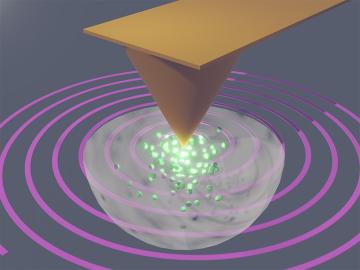Filter News
Area of Research
- Advanced Manufacturing (16)
- Biological Systems (2)
- Biology and Environment (76)
- Building Technologies (7)
- Chemical and Engineering Materials (1)
- Chemistry and Physics at Interfaces (1)
- Clean Energy (230)
- Climate and Environmental Systems (4)
- Computational Biology (1)
- Computational Engineering (2)
- Computer Science (10)
- Data (1)
- Electricity and Smart Grid (1)
- Energy Frontier Research Centers (1)
- Energy Sciences (2)
- Fossil Energy (1)
- Functional Materials for Energy (1)
- Fusion and Fission (11)
- Fusion Energy (8)
- Isotope Development and Production (2)
- Isotopes (14)
- Materials (109)
- Materials for Computing (10)
- Materials Synthesis from Atoms to Systems (1)
- Materials Under Extremes (1)
- Mathematics (1)
- National Security (24)
- Neutron Data Analysis and Visualization (2)
- Neutron Science (43)
- Nuclear Science and Technology (23)
- Nuclear Systems Modeling, Simulation and Validation (2)
- Quantum information Science (3)
- Renewable Energy (3)
- Sensors and Controls (3)
- Supercomputing (50)
- Transportation Systems (2)
News Type
Date
News Topics
- 3-D Printing/Advanced Manufacturing (42)
- Advanced Reactors (15)
- Artificial Intelligence (16)
- Big Data (20)
- Bioenergy (31)
- Biology (37)
- Biomedical (19)
- Biotechnology (6)
- Buildings (26)
- Chemical Sciences (15)
- Clean Water (19)
- Climate Change (34)
- Composites (11)
- Computer Science (51)
- Coronavirus (17)
- Critical Materials (12)
- Cybersecurity (9)
- Decarbonization (21)
- Energy Storage (44)
- Environment (79)
- Exascale Computing (3)
- Frontier (3)
- Fusion (15)
- Grid (27)
- High-Performance Computing (19)
- Hydropower (8)
- Irradiation (2)
- Isotopes (13)
- ITER (4)
- Machine Learning (14)
- Materials (41)
- Materials Science (43)
- Mathematics (4)
- Mercury (7)
- Microscopy (20)
- Molten Salt (5)
- Nanotechnology (18)
- National Security (17)
- Net Zero (3)
- Neutron Science (35)
- Nuclear Energy (31)
- Partnerships (1)
- Physics (20)
- Polymers (13)
- Quantum Computing (5)
- Quantum Science (12)
- Security (6)
- Simulation (10)
- Space Exploration (10)
- Statistics (1)
- Summit (8)
- Sustainable Energy (55)
- Transportation (47)
Media Contacts

Although he built his career around buildings, Fengqi “Frank” Li likes to break down walls. Li was trained as an architect, but he doesn’t box himself in. Currently he is working as a computational developer at ORNL. But Li considers himself a designer. To him, that’s less a box than a plane – a landscape scattered with ideas, like destinations on a map that can be connected in different ways.

To capitalize on AI and researcher strengths, scientists developed a human-AI collaboration recommender system for improved experimentation performance.

Chelsea Chen, a polymer physicist at ORNL, is studying ion transport in solid electrolytes that could help electric vehicle battery charges last longer.

Research led by ORNL’s Marti Checa and Liam Collins has pioneered a groundbreaking approach described in the journal Nature Communications that enables visualizing charge motion at the nanometer level, or one billionth of a meter, but at speeds thousands of times faster than conventional methods.

ORNL climate modeling expertise contributed to a project that assessed global emissions of ammonia from croplands now and in a warmer future, while also identifying solutions tuned to local growing conditions.

Ilenne Del Valle is merging her expertise in synthetic biology and environmental science to develop new technologies to help scientists better understand and engineer ecosystems for climate resilience.

ORNL researchers have developed a novel way to encapsulate salt hydrate phase-change materials within polymer fibers through a coaxial pulling process. The discovery could lead to the widespread use of the low-carbon materials as a source of insulation for a building’s envelope.

Scientists at the Department of Energy’s Oak Ridge National Laboratory are using a new modeling framework in conjunction with data collected from marshes in the Mississippi Delta to improve predictions of climate-warming methane and nitrous oxide

Researchers demonstrated that stainless steel and other metal alloys coated with hexagonal boron nitride, or hBN, exhibit non-stick or low-friction qualities along with improved long-term protection against harsh corrosion and high-temperature

Louise Stevenson uses her expertise as an environmental toxicologist to evaluate the effects of stressors such as chemicals and other contaminants on aquatic systems.




